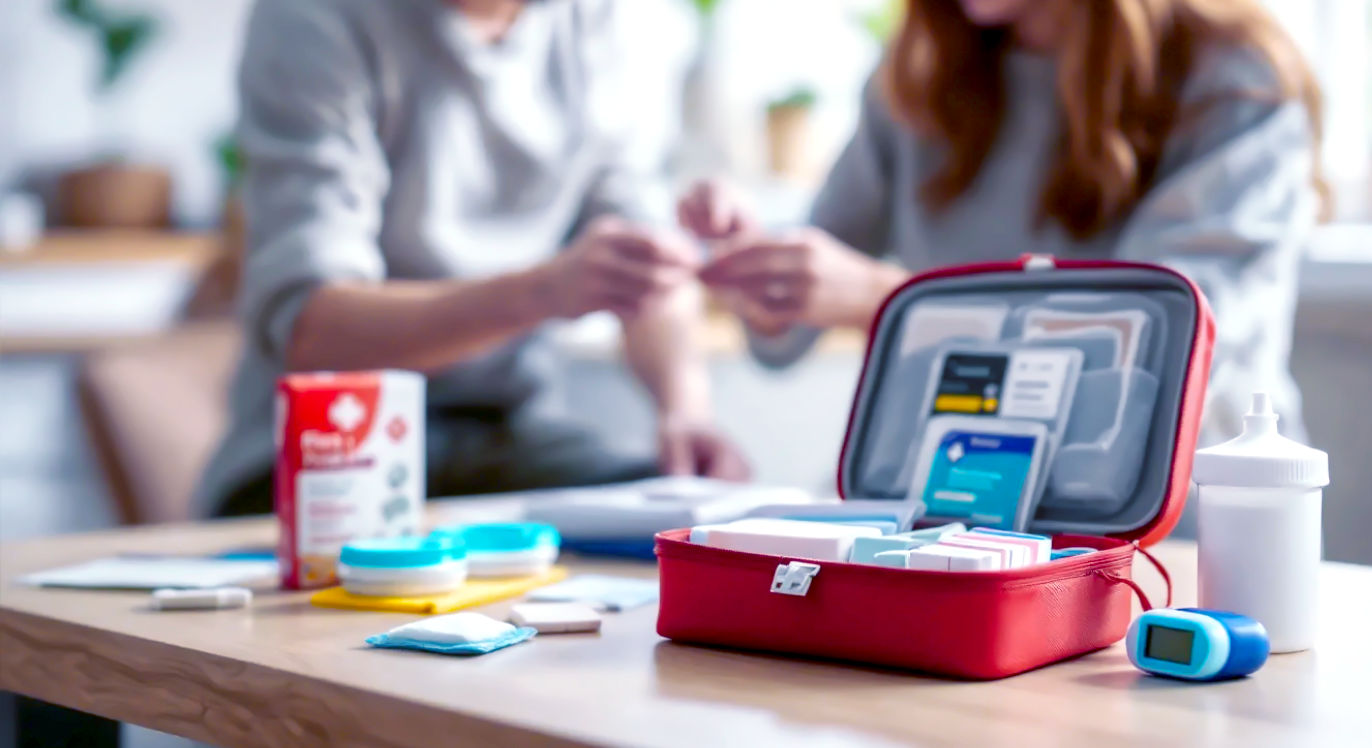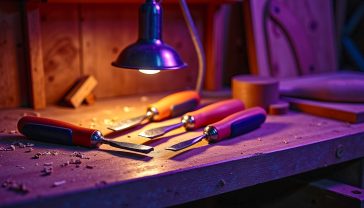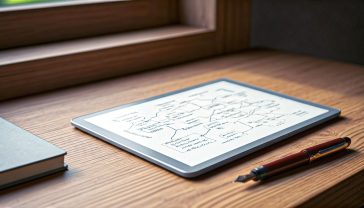What to Include in a First Aid Kit: The Ultimate UK Guide to Must-Have Items
Your guide to building the perfect first aid kit. Discover the must-have items for your home, car, and travels with our essential UK checklist.

This post may contain affiliate links. If you make a purchase through these links, we may earn a commission at no additional cost to you.
Picture this: you’re enjoying a sunny Saturday afternoon at the local park. The kids are tearing around the playground, full of energy. Suddenly, there’s a wobble, a trip, and a wail. Your little one has taken a tumble off the swings and has a nasty-looking graze on their knee. Tears are flowing, and everyone’s looking at you. What do you do?
For many of us, the instinct is to panic a little. But imagine reaching into your bag, pulling out a small, organised kit, and calmly sorting the situation out. A quick clean of the wound, a colourful plaster, a cuddle, and before you know it, they’re back to playing. That’s not just good parenting; it’s the quiet confidence that comes from being prepared.
In Britain, we have a certain fondness for the “keep calm and carry on” spirit. But carrying on is a lot easier when you have the right tools for the job. A first aid kit is exactly that—a simple but essential toolkit for life’s little bumps, scrapes, and stings. It’s not about being ready for a major catastrophe; it’s about having the power to make things better when a minor mishap occurs, whether you’re at home, in the car, or halfway up a hill in the Lake District.
This guide will walk you through everything you need to know about building the perfect first aid kit. We’ll cover the absolute must-haves for your home, how to tailor kits for your car or for travelling, and even what to pack for the littlest members of your family. Think of it as your ultimate cheat sheet for being the calm, collected person everyone turns to when a plaster is needed.
The Heart of the Matter: What Exactly Is a First Aid Kit?
At its simplest, a first aid kit is a collection of supplies used to give immediate medical treatment. It’s your first line of defence for dealing with minor injuries like cuts, grazes, minor burns, and sprains. It’s not meant to replace professional medical help, but it’s there to manage the situation until you can get it, or to sort out problems that don’t need a trip to A&E.
Before you even open the kit, it’s worth remembering the three Cs of any emergency:
- Check: Check the scene for any dangers. Is it safe for you to help? Then, check the person. Are they conscious? Are they breathing?
- Call: If it’s a serious emergency, call 999 immediately. Don’t delay.
- Care: Give first aid until help arrives. This is where your kit comes in.
Choosing Your Kit’s Home: Bag or Box?
You can buy pre-made first aid kits from places like St John Ambulance, the British Red Cross, or your local chemist. These are a great starting point. Alternatively, you can build your own.
When it comes to the container, you’ve got two main choices: a soft bag or a hard box.
- Soft Bags: These are often made of durable, water-resistant fabric and have lots of pockets and compartments. They’re brilliant for travel or for keeping in the car because they’re lightweight and can be squeezed into tight spaces.
- Hard Boxes: These are typically made of plastic and have a handle. They’re great for home or workplace kits because they’re sturdy, easy to clean, and protect the contents from being squashed. Look for one with a secure clasp to stop everything from spilling out.
Whichever you choose, make sure it’s clearly labelled. A green box with a white cross is the universally recognised symbol for first aid. This helps everyone find it in a hurry.
The Ultimate Home First Aid Kit Checklist: Your Essential Arsenal
Every home should have a central first aid kit stored somewhere that’s easy to get to, but out of the reach of young children. A kitchen cupboard is often a good spot. Here’s a rundown of the absolute essentials you should have inside.
Dressings and Bandages: The Nuts and Bolts
This is the stuff you’ll use most often. It’s all about cleaning, covering, and protecting wounds to stop bleeding and prevent infection.
Plasters (or Sterile Adhesive Dressings)
You can never have too many plasters. A scraped knee, a papercut, or a blister from new shoes—plasters are your best friend. Get a mixed pack with a variety of shapes and sizes. It’s also wise to have a few different types:
- Fabric plasters: These are flexible and breathable, great for joints like knees and elbows.
- Waterproof plasters: Perfect for hands, as they’ll stay on even after you’ve washed them.
- Hypoallergenic plasters: A must-have if anyone in your family has sensitive skin.
Sterile Dressings
For injuries that are too big for a plaster, you’ll need a sterile dressing. These are pads of absorbent gauze with a bandage attached. They protect the wound and help to stop bleeding. You should have a few in different sizes:
- Medium and Large: For cuts on arms or legs.
- Extra Large: For more significant injuries. An eye pad dressing is also a very useful addition.
Bandages
Bandages have a few different jobs, from holding dressings in place to supporting injured limbs.
- Triangular Bandages: These are incredibly versatile. You can use them as a sling to support an arm, as a bandage to hold a dressing in place, or as a pad to apply pressure to a wound. Keep at least two in your kit.
- Crepe Roller Bandages: These are stretchy bandages that are great for supporting a sprained wrist or ankle. They provide gentle compression, which can help reduce swelling.
- Conforming Bandages: These are lightweight, stretchy bandages that mould to the body’s shape. They are ideal for securing dressings on tricky areas like a hand or foot.
Adhesive Tape
Microporous tape is the best choice for a first aid kit. It’s a bit like medical-grade masking tape. It’s gentle on the skin but strong enough to hold a dressing in place. It’s also easy to tear, so you don’t need scissors in a pinch.
Cleaning and Disinfecting: Keeping Germs at Bay
Cleaning a wound is the most important step in preventing infection. Your kit should have a few key items to help with this.
- Alcohol-Free Antiseptic Wipes: These are individually wrapped wipes used to clean the skin around a wound. Don’t use them directly on the wound itself, as they can be a bit harsh. Instead, use them to wipe away any dirt from the surrounding area before you apply a dressing.
- Saline Solution or Sterile Water: This is the best thing for cleaning out a cut or graze. You can buy small pods of sterile saline solution, which are perfect for flushing grit or dirt out of a wound without stinging.
- Hand Sanitiser: Before you treat someone, you need to make sure your own hands are clean. A small bottle of alcohol-based hand gel is a quick and effective way to do this if you can’t get to a sink.
Tools and Equipment: The Gadgets of Your Kit
These are the tools that make giving first aid easier and safer.
- Scissors: A small, tough pair of scissors is essential. Tuff-cut scissors are fantastic because they can cut through clothing, seatbelts, and leather if necessary, but have a rounded bottom edge to avoid injuring the skin.
- Tweezers: For getting out splinters, thorns, or bits of grit from a wound. A pair with a fine, pointed tip is best. Remember to clean them before and after each use.
- Safety Pins: Useful for securing bandages or slings. Keep a handful of different sizes.
- Disposable Gloves: Always put on a pair of disposable gloves before you treat an injury that involves blood or other body fluids. This protects both you and the person you’re helping from infection. Keep a few pairs in your kit. Nitrile gloves are a good choice as some people are allergic to latex.
- Foil Blanket: Also known as an emergency or space blanket, this thin, silvery sheet is a lifesaver if someone is in shock or suffering from hypothermia. It reflects body heat back onto the person, helping to keep them warm. They’re tiny and weigh almost nothing, so they’re easy to include.
- Digital Thermometer: Useful for checking if someone has a fever. A digital one is much safer and easier to use than the old-fashioned mercury thermometers.
- Face Shield or Resuscitation Mask: If you ever have to give someone CPR, a face shield provides a protective barrier to prevent the exchange of fluids. It’s a small item that offers peace of mind.
Ointments and Medication: Potions for Pain and Problems
It’s a good idea to keep a small supply of basic, over-the-counter medicines in your kit. Always make sure they are clearly labelled and check the expiry dates regularly.
- Painkillers: Paracetamol and ibuprofen are the two essentials. They’re good for headaches, muscle pain, and reducing fever. Ibuprofen is also an anti-inflammatory, so it’s particularly good for sprains and strains. Remember to have liquid versions for children if you have them.
- Antihistamines: A must-have for dealing with insect bites, stings, and allergic reactions like hay fever or hives. You can get them as tablets or as a cream.
- Hydrocortisone Cream: A mild steroid cream that’s very effective at calming down skin irritation from insect bites, nettle rash, or eczema.
- Calamine Lotion: The classic, old-fashioned remedy for soothing sunburn, chickenpox, and other itchy skin conditions.
- Aspirin: If you have adults in the house, it can be life-saving to have aspirin available. A single 300mg tablet, chewed slowly, can help someone who is having a suspected heart attack while you wait for the ambulance. Do not give aspirin to anyone under 16.
A final note: your first aid kit should not contain any personal prescription medication. These should be stored separately.
Beyond the Basics: Tailoring Your Kit to Your Life
A one-size-fits-all approach doesn’t really work for first aid. The perfect kit depends on your lifestyle. Here’s how to adapt your kit for different situations.
The Car First Aid Kit
Keeping a kit in your car is a brilliant idea. You’re more likely to come across an accident while driving, and having a kit means you can help. A good car kit should have all the home kit essentials, plus a few extras:
- A High-Visibility Jacket: To make you visible and safe at the roadside.
- A Warning Triangle: To alert other drivers to a hazard.
- A Notepad and Pencil: For recording details after an accident.
- Sickness Bags: For travel-sick passengers.
If you plan on driving in Europe, many countries legally require you to carry a first aid kit, warning triangle, and high-vis jacket.
The Travel First Aid Kit
When you go on holiday, the last thing you want is to be hunting for a pharmacy in a foreign country. A small travel kit can be a real holiday-saver. Pack a lightweight bag with smaller quantities of the essentials:
- Plasters, wipes, and sterile dressings.
- Painkillers and antihistamines.
- Sun cream and after-sun lotion.
- Insect repellent, especially if you’re going somewhere tropical. Choose one with DEET.
- Rehydration Salts: Sachets like Dioralyte are invaluable for treating dehydration caused by diarrhoea, vomiting, or just too much sun.
- Water Purification Tablets: Essential if you’re travelling to a place where the tap water isn’t safe to drink.
- Any personal medication, with a copy of your prescription.
The Workplace First Aid Kit
By law, all employers in the UK have to provide adequate first aid equipment for their staff. What’s considered “adequate” depends on the workplace. An office will have different needs to a construction site.
The Health and Safety Executive (HSE) provides guidance on this. Many workplaces follow the BS 8599-1 standard, which specifies the contents for small, medium, and large kits. These kits contain more of the core items, like dressings and wipes, and are designed for dealing with common workplace injuries.
The Baby and Child First Aid Kit
Children are magnets for minor injuries. A dedicated kit for them is a great idea. It should include:
- Children’s plasters with fun designs. They can be a great distraction!
- Liquid paracetamol and ibuprofen suitable for their age.
- A syringe or medicine spoon for accurate dosing.
- Teething gel for sore gums.
- Nappy rash cream.
- A digital thermometer designed for children, perhaps one that takes a reading from the ear or forehead.
The Sports and Outdoor First Aid Kit
If you’re a keen hiker, cyclist, or play sports regularly, your kit needs a few special items for dealing with blisters, bumps, and sore muscles.
- Blister Plasters: Compeed or similar hydrocolloid plasters are amazing. They cushion the blister and help it heal faster.
- Instant Ice Packs: These single-use packs turn cold instantly when you squeeze them. They’re brilliant for treating sprains and strains on the go.
- Muscle Rub or Freeze Spray: For soothing aching muscles after a long day’s activity.
- Tick Remover: A small, specially designed tool for safely removing ticks if you’ve been walking through long grass.
How to Use Your Kit: Simple Skills That Save the Day
Having a kit is one thing; knowing how to use it is another. You don’t need to be a medical expert, but learning some basic first aid will give you the confidence to act. St John Ambulance and the British Red Cross run excellent first aid courses all over the country.
Here’s a quick guide to using your kit for some common problems.
For Cuts and Grazes
- Clean your hands and put on disposable gloves.
- Clean the wound by rinsing it with saline solution or running it under cool water. Pat it dry with a sterile gauze swab.
- Apply a plaster or sterile dressing, making sure it’s big enough to cover the entire wound.
- Change the dressing every day, or sooner if it gets wet or dirty.
For Sprains and Strains
Remember the acronym RICE:
- Rest: Stop the activity and rest the injured joint.
- Ice: Apply an ice pack (wrapped in a tea towel) for 10-15 minutes every few hours to reduce swelling.
- Compression: Use a crepe roller bandage to apply gentle, even pressure. Make sure it’s not too tight.
- Elevation: Keep the injured part raised to help reduce swelling.
For Minor Burns
- Cool the burn immediately under cool running water for at least 20 minutes. This is the most important step.
- Remove any jewellery or clothing near the burn, unless it’s stuck to the skin.
- Cover the burn with a layer of cling film or a clean plastic bag. This keeps it clean and stops the air from getting to it, which helps with the pain. Don’t wrap it tightly. A sterile, non-fluffy dressing can also be used.
- Take painkillers like paracetamol or ibuprofen.
When Should You Call 999?
Your first aid kit is for minor injuries. For serious emergencies, you need professional help, fast. Call 999 immediately if someone:
- Is unconscious or not breathing.
- Is having a suspected heart attack or stroke.
- Is bleeding heavily and you can’t stop it.
- Has a severe burn.
- Has a broken bone.
Keeping Your Kit in Good Shape: Your First Aid MOT
Your first aid kit needs a bit of maintenance to make sure it’s ready when you need it.
- Check it regularly: At least every six months, go through your kit.
- Check expiry dates: Many items, especially sterile dressings and medicines, have expiry dates. Replace anything that’s out of date.
- Check for damage: Make sure the packaging on sterile items is still intact.
- Restock: Whenever you use something from the kit, make a note to replace it as soon as possible. Don’t wait until the next emergency.
Store your kit in a cool, dry place. The bathroom isn’t ideal because the steam from the shower can damage the contents.
A Quick Look Back: The History of First Aid
The idea of organised first aid is relatively modern. It grew out of the battlefields of the 19th century. In 1859, a Swiss businessman named Henry Dunant witnessed the horrific aftermath of the Battle of Solferino in Italy. He organised local volunteers to care for the wounded, regardless of which side they were on. This experience led him to help found the Red Cross.
In Britain, the concept was pushed forward by organisations like St John Ambulance, which was founded in 1877 to teach first aid to ordinary people in industrial areas like factories and railway depots. Their mission was simple: that everyone who needs it should receive first aid from those around them. That principle is just as important today.
Be Prepared, Not Scared
A well-stocked first aid kit is one of the most useful things you can have in your home. It’s a small investment of time and money that pays huge dividends when you need it. It empowers you to handle those everyday mishaps with confidence and care.
So, take half an hour this weekend. Go and find your first aid kit. Is it where you thought it was? Open it up, check what’s inside, and replace anything that’s missing or out of date. If you don’t have one, make it your mission to build one.
You’ll probably tuck it away in a cupboard and forget about it for months. But one day, when a finger gets sliced instead of an onion, or a knee gets grazed in the garden, you’ll be incredibly glad you have it. You’ll be the calm, capable person who knows just what to do. And that’s a great feeling.
Further Reading and Resources
For more detailed information and to book first aid courses, these UK-based resources are invaluable:






